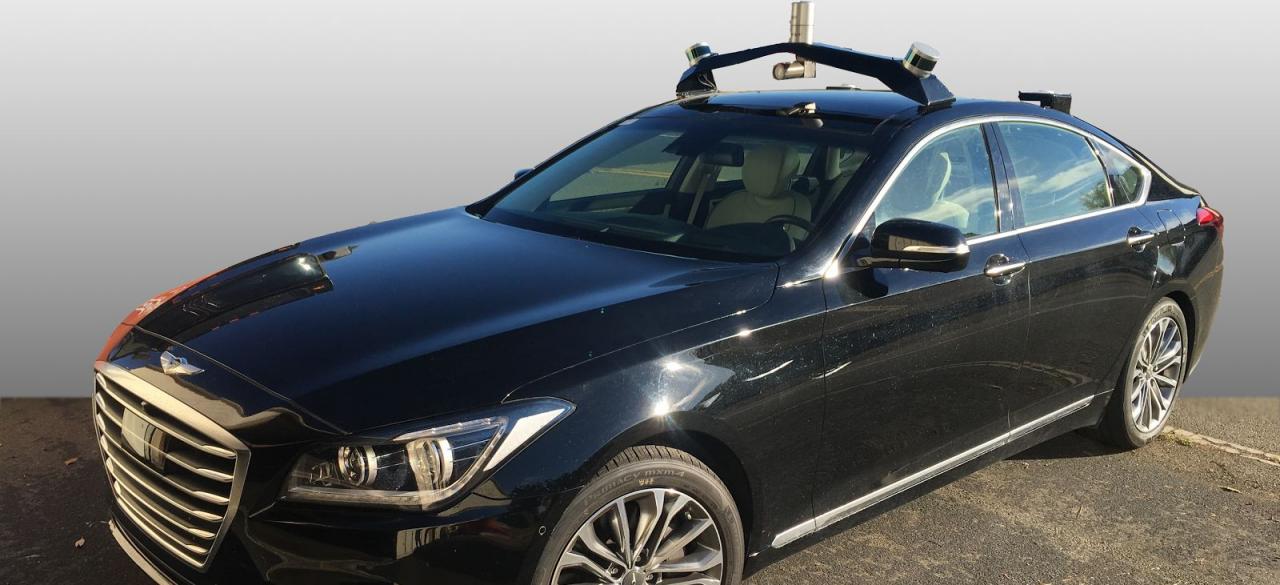Public-Road Demonstration of the BDD/HCE Autonomous Driving Car

ABOUT THE PROJECT
At a glance
In 2017, the MPC lab partnered with BDD and Hyundai to develop a new generation of autonomous vehicles, a Hyundai Genesis G380. This vehicle is equipped with four latest Velodyne lidar sensors for 360 degree object detection, a Point Grey camera, an Oxford RTK GPS system, and CAN access to the vehicle’s lateral and longitudinal control interfaces.
This proposal focuses on finalizing the experimental vehicle setup and demonstrating an advanced autonomous capability on public-roads. The proposed research and development initiatives follow under the BDD proposal categories of “Advanced Machine Learning for Autonomous Driving” and “Functionality and Applications for Automated Driving”.
The Model Predictive Control Laboratory has over a decade of experience in control systems research for autonomous vehicles. Our work has been demonstrated across diverse testing environments, including limited scenarios on public roads. Over the next year, we propose a research and development project that will culminate in a safe demonstration of the BDD/HCE vehicle’s autonomous driving capabilities on public highways and urban roads.
For the vehicle’s perception system, we will develop real-time algorithms for fusing the output of our vehicle’s four lidar sensors. Development in this area include calibration and registration of point clouds to the vehicle frame coordinates, time synchronization, and rolling shutter correction. With a global point cloud assembled, we will test and compare several BDD algorithms for vehicle and pedestrian detection with lidar and camera fusion. Our work in this area is already underway, and we estimate that we need to fund one researcher for three additional months of work for completion. Successful completion of this initiative will enable our car to detect obstacles with high accuracy for safe driving in dense urban environments.
In the second phase we will develop model-based low-level control algorithms by conducting data- and model-driven system identification on our vehicle’s low-level control systems. These will be very useful for test End-to-End algorithms in the future. As in most production vehicles, our access to the engine, brake, and steering systems is through several black-box low-level control systems engineered by Tier 1 suppliers or OEMs. We know from internal experience across several experimental vehicles, as well as from knowledge from industry partners, that developing a reliable and accurate understanding of these closed-source systems is essential to trustworthy and safe autonomous vehicle control but it remains a challenging problem. To address this problem, we propose a data-driven machine learning system identification project. We will collect vehicle data using these low-level systems across a broad range of operating conditions, train several candidate models such as an LSTM network, and then test and validate model performance.
In the last phase of the project we will use the learned models of our low-level systems to design high-level control algorithms. In particular, by employing recent advances in data-driven predictive control [1], our goal will be to design high-performance safe controllers with focus on safety and comfort. By continuously learning our low-level controllers, we can vertically integrate the learning and control process, to continuously improve the performance and comfort of our high-level controllers while ensuring safety at all times [2-3]. While these models will be specific to our BDD/HCE vehicle, the modeling techniques and software developed will be transferable to other BDD vehicles, which face similar control challenges. The project will be concluded with two on-road demonstrations. We will first test our algorithm on Hyundai’s California Proving Grounds (CPG) facility, which includes a 150000 m2 vehicle dynamics area for safe testing. The tests at CPG will allow us to tune our algorithm over a comprehensive range of the vehicle’s operating capabilities. Later, in our final experiment, we will take the Hyundai Genesis G380 to public roads, and perform lane keeping and lane change maneuvers.
| PRINCIPAL INVESTIGATORS | RESEARCHERS | THEMES |
|---|---|---|
| Francesco Borrelli, Ching-Yao Chan and Trevor Darrell | Greg Marcil and George Xiaojing Zhang | Autonomous Driving, Machine Learning, System Identification, Adaptive Control |

